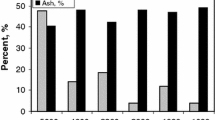Abstract
Beneficiation of coal is a water intensive process, and the water is recovered in downstream operations in the high rate thickener (HRT) and vacuum belt filtration (VBF). Clean coal particles entering the HRT have an inherent tendency to enter the overflow because they are extremely fine and hydrophobic. Hence, flocculants (polymers) are used to floc the ultrafine particles so that they settle and enter the underflow. Ultrafine coal particles (−37 μ), which are highly hydrophobic, if present in the stream, will not be efficiently captured by using flocculants alone. This is observed in the normal plant operation at one of the beneficiation plants in the Jharia region, Jharkhand, India. Approximately 6–7% of the feed to the HRT enters the over flow (supernatant water). Hence, this amount of clean coal particles is not recovered and account for production losses. A comprehensive settling and dewatering test work was conducted with clean coal slurry using several commercially available reagents. Studies were also done on different combinations of reagents, including coagulants and surfactants along with flocculants, to improve the settling behavior of the coal particles. The reagents were assessed based on their performance with respect to settling rates, overflow water clarity, and compaction of the underflow solids. Emphasis was given to the ability of the reagents in compacting thickener underflow to higher densities so that maximum water could be recovered from the thickener. Pretreatment of highly hydrophobic coal slurry with a combination of coagulant and surfactant followed by flocculation showed very good settling characteristics with clear overflow.







Similar content being viewed by others
References
Patra AS, Makhija D, Mukherjee AK, Tiwari R, Sahoo CR, Mohanty BD (2016) Improved dewatering of iron ore fines by the use of surfactants. Powder Technol 287:43–50. https://doi.org/10.1016/j.powtec.2015.09.030
Rahimi M, Abdollahzadeh AA, Rezai B (2015) The effect of particle size, pH, and flocculant dosage on the gel point, effective solid stress, and thickener performance of a coal-washing plant. Int J Coal Prep Util 35:125–142. https://doi.org/10.1080/19392699.2014.996288
Noble A, Luttrell GH (2015) A review of state-of-the-art processing operations in coal preparation. Int J Min Sci Technol 25:511–521. https://doi.org/10.1016/j.ijmst.2015.05.001
Alam N, Ozdemir O, Hampton MA, Nguyen AV (2011) Dewatering of coal plant tailings: flocculation followed by filtration. Fuel. 90:26–35. https://doi.org/10.1016/j.fuel.2010.08.006
OruÇ F, Sabah E (2006) Effect of mixing conditions on flocculation performance of fine coal tailings, IMPC 2006 – Proc 23rd Int Miner Process Congr, pp 1192–1198
Sabah E, Yüzer H, Çelik MS (2004) Characterization and dewatering of fine coal tailings by dual-flocculant systems. Int J Miner Process 74:303–315. https://doi.org/10.1016/j.minpro.2004.03.001
Trelles IJ, Mahamud MM, Lavín AG, Díaz M (2017) Sludge settling prediction in sequencing batch reactor plants. J Clean Prod 152:115–124. https://doi.org/10.1016/j.jclepro.2017.03.115
Concha F, Rulyov NN, Laskowski JS (2012) Settling velocities of particulate systems 18: solid flux density determination by ultra-flocculation. Int J Miner Process 104–105:53–57. https://doi.org/10.1016/j.minpro.2011.12.007
Vaziri Hassas B, Karakaş F, Çelik MS (2014) Ultrafine coal dewatering: relationship between hydrophilic lipophilic balance (HLB) of surfactants and coal rank. Int J Miner Process 133:97–104. https://doi.org/10.1016/j.minpro.2014.10.010
Wang C, Harbottle D, Liu Q, Xu Z (2014) Current state of fine mineral tailings treatment: a critical review on theory and practice. Miner Eng 58:113–131. https://doi.org/10.1016/j.mineng.2014.01.018
Duzyol S, Sensogut C (2015) The relation between hydrophobic flocculation and combustion characteristics of coal. Fuel Process Technol 137:333–338. https://doi.org/10.1016/j.fuproc.2015.03.021
Parekh BK (2009) Dewatering of fine coal and refuse slurries-problems and possibilities. Procedia Earth Planet Sci 1:621–626. https://doi.org/10.1016/j.proeps.2009.09.098
Menkiti MC, Nnaji PC, Nwoye CI, Onukwuli OD (2010)Coag-flocculation kinetics and functional parameters response of Mucuna seed coagulant to pH variation in organic rich coal effluent medium. J Miner Mater Charact Eng 09:89–103. https://doi.org/10.4236/jmmce.2010.92008
Ofori P, Nguyen AV, Firth B, McNally C, Hampton MA (2012) The role of surface interaction forces and mixing in enhanced dewatering of coal preparation tailings. Fuel. 97:262–268. https://doi.org/10.1016/j.fuel.2012.02.048
Coca J, Bueno JL, Sastre H (1983) Zeta potential and effect of coagulants on coal slurries. J Chem Eng Japan 16:335–338
Parsapour GA, Hossininasab M, Yahyaei M, Banisi S (2014) Effect of settling test procedure on sizing thickeners. Sep Purif Technol 122:87–95. https://doi.org/10.1016/j.seppur.2013.11.001
Sabah E, Erkan ZE (2006) Interaction mechanism of flocculants with coal waste slurry. Fuel 85:350–359. https://doi.org/10.1016/j.fuel.2005.06.005
Boylu F, Dinçer H, Ateşok G (2004) Effect of coal particle size distribution, volume fraction and rank on the rheology of coal-water slurries. Fuel Process Technol 85:241–250. https://doi.org/10.1016/S0378-3820(03)00198-X
Aidarova S, Bekturganova N, Kerimkulova M, Musabekov K, Sharipova A (2014) The influence of surfactants to the stability of coal water suspension. Period Polytech Chem Eng 58:21–26. https://doi.org/10.3311/PPch.7300
Nowak E, Combes G, Stitt EH, Pacek AW (2013) A comparison of contact angle measurement techniques applied to highly porous catalyst supports. Powder Technol 233:52–64. https://doi.org/10.1016/j.powtec.2012.08.032
Kumar S, Bhattacharya S, Mandre NR (2014) Characterization and flocculation studies of fine coal tailings. J South African Inst Min Metall 114:945–949
Author information
Authors and Affiliations
Corresponding author
Ethics declarations
Conflict of Interest
The authors declare that they have no conflict of interest.
Additional information
Publisher’s Note
Springer Nature remains neutral with regard to jurisdictional claims in published maps and institutional affiliations.
Rights and permissions
About this article
Cite this article
Azad, M.N., Patra, A.S., Sachinraj, D. et al. New Process for Recovery of Ultra Fine Coal by Pre-Treatment with Surfactant. Mining, Metallurgy & Exploration 38, 2517–2526 (2021). https://doi.org/10.1007/s42461-021-00485-w
Received:
Accepted:
Published:
Issue Date:
DOI: https://doi.org/10.1007/s42461-021-00485-w




